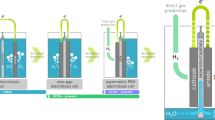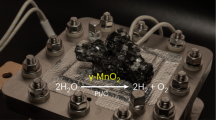Abstract
THE potential assumed by an iron electrode immersed in a culture of sulphate-reducing bacteria has been studied by Hadley1, using a heterotrophic medium. These experiments indicated that the inoculation of the sterile medium, in which the potential of an iron electrode had been allowed to reach a steady value, was followed by a movement of the potential in the anodic (negative) direction. This, in turn, was followed by a rise to a steady value more cathodic (positive) than the initial value in a sterile medium. These changes of potential are shown diagrammatically in the accompanying graph. We feel, however, unable to agree with the explanation given for the first fall of potential, namely, that it is due to bacterial utilization of hydrogen with consequent depolarization of the cathodic areas. Such a depolarization should lead to a potential change in the cathodic (positive) direction, as may be seen from a consideration of the Evans polarization diagram for a corroding system. We also feel unable to accept the statement that the final steady potential(− 0.370 V., normal hydrogen scale) is due to the establishment of the Fe/FeS/S″ equilibrium, on the grounds that this value is too positive for such an equilibrium. It is, in fact, more positive than the standard Fe/Fe++ potential(− 0.441 V.) and would thus imply a concentration of ferrous ions of greater than 1 M. Such a concentration seems impossible in the presence of the large amounts of sulphide produced under heterotrophic conditions.
This is a preview of subscription content, access via your institution
Access options
Subscribe to this journal
Receive 51 print issues and online access
$199.00 per year
only $3.90 per issue
Buy this article
- Purchase on Springer Link
- Instant access to full article PDF
Prices may be subject to local taxes which are calculated during checkout
Similar content being viewed by others
References
Hadley, R. F., U.S. Bureau of Standards Corrosion Conference, March 1943.
Spruit, C. J. P., and Wanklyn, J. N., Nature, [168, 951 (1951)].
Author information
Authors and Affiliations
Rights and permissions
About this article
Cite this article
WANKLYN, J., SPRUIT, C. Influence of Sulphate-reducing Bacteria on the Corrosion Potential of Iron. Nature 169, 928–929 (1952). https://doi.org/10.1038/169928b0
Issue Date:
DOI: https://doi.org/10.1038/169928b0
This article is cited by
-
A proton-deuterium exchange study of three types ofDesulfovibrio hydrogenases
Journal of Industrial Microbiology (1987)
-
Purification and characterization of three proteins from a halophilic sulfate-reducing bacterium,Desulfovibrio salexigens
Journal of Industrial Microbiology (1986)
-
Corrosion of Pembina crude oil pipeline
European Journal of Applied Microbiology and Biotechnology (1983)
-
Corrosion by the Sulphate-reducing Bacteria
Nature (1971)
Comments
By submitting a comment you agree to abide by our Terms and Community Guidelines. If you find something abusive or that does not comply with our terms or guidelines please flag it as inappropriate.



